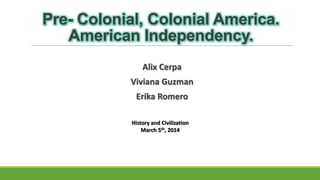
Oral presentation america
- 1. Pre- Colonial, Colonial America. American Independency. Alix Cerpa Viviana Guzman Erika Romero History and Civilization March 5th, 2014
- 3. •Pre-Columbian time period. •First Americans came from Asia •Crossed the Bering Strait during the Ice Age •Following a food source •Gradual migration
- 4. Early Human Migrations 1st Migration, 38,000-1800 BCE 2nd Migration, c. 10,000-4,000 BCE 3rd Migration, c. 8,000-3,000 BCE
- 5. The first people to live in North America came from Asia. They crossed a land bridge called Beringia, which used to connect Asia to North America. They came here to follow animals to hunt, making them nomads. After the Ice Age, this bridge went underwater. These people became the Native Americans.
- 6. Culture area
- 7. Before Europeans arrived in North America, Native peoples inhabited every region. This map shows Native American tribes, culture areas, and linguistic stocks.
- 8. Diversity of Native American Groups The structures Native Americans called home were extremely varied and often exclusive to tribe or region. These "apartment" style dwellings were the work of Natives of the Southwest. The Natchez chief, known as "Great Sun," was a powerful Indian leader. Unlike some Indian leaders, "Great Sun" ruled as an absolute monarch. "In the beginning, this place was only darkness and water until the time when a woman fell from the sky world." Thus starts the Oneida creation story. Every Native American tribe has their own history, culture, and art.
- 9. The Anasazi According to Anasazi legend, Kokopelli was a little man who traveled from village to village with a flute and a sack of corn. At night he would play his flute among the fields, and the people would awake to find the crops taller than ever before. The Anasazi built their dwellings under overhanging cliffs to protect them from the elements. Using blocks of sandstone and a mud mortar, the tribe crafted some of the world's longest standing structures. One component of the Anasazi community were the kivas. These structures were used for religious celebrations. This kiva is from the Sand Canyon Pueblo, Crow Canyon, in the Mesa Verde region and dates back to the 13th century.
- 10. The Algonkian Tribes Massasoit, sachem of the Wampanoag tribe and father of Metacomet, meets with settlers. The Wampanoag helped the settlers survive their first winter by providing them with much needed supplies. But as more and more colonists arrived in New England, their relationship began to deteriorate. This painting, by Tall Oak of the Narragansett tribe, depicts a scene from King Philip's War which pitted Metacomet against the British settlers.
- 11. The Iroquois Tribes The Masssachusetts Mohawk Trail began as a Native American footpath used for trade, hunting, and social calling by five tribes, including the Pocumtuck and the Mohawk. Mohawk Indian chief Joseph Brant served as a spokesman for his people, a Christian missionary of the Anglican church, and a British military officer during the Revolutionary War. The Iroquoi Tribes, also known as the Haudenosuanee, are known for many things. But they are best known for their longhouses. Each longhouse was home to many members of a Haudenosuanee family.
- 12. WHITE EUROPEANS •Used the land for economic needs •Clearing the land, destroying hunting areas and fencing it off into private property •Divided the land and selling it for monetary value. NATIVE AMERICANS •Relationship with environment as part of their religion •Need to hunt for survival •Ownership meant access to the things the land produced, not ownership of the land itself.
- 13. Why did European nations establish colonies in North America?
- 14. Direct Causes = 3 G’s Political: Become a world power through gaining wealth and land. (GLORY) Economic: Search for new trade routes with direct access to Asian/African luxury goods would enrich individuals and their nations (GOLD) Religious: spread Christianity and weaken Middle Eastern Muslims. (GOD) The 3 motives reinforce each other
- 17. Colonial América
- 18. Important aspects English settlers came to work for private companies, thanks to the English Crown. Virginia Company of London, founded Virginia in 1607. The colonists were the landless, unemployed, and those who wanted religious fredoom.
- 19. PILGRIm FATHERS Were the most famous of settlers. They set sail on the mayflower (ship) and landed at cape cod in New Ingland. The colonists fail in recognize the existing civilizations of America, and they called the natives as “barbarians”.
- 20. SHIPWRECKEDS They were thankfull for the land, and they prayed to god because they could they were scared for the ocean. They did not have places to stay, no friends, no inns, no wáter to refresh their bodies. The “barbarians”, helped them, they gave them some water to refresh, but they were ready to atack them. The Winter in that place was really strong, too cold and cruel, full of storms. This land were desolated and there were a lot of wild animals and men.
- 21. Britain colonies in America
- 33. BOSTON TEA PARTY 1773. The Boston Tea Party (initially referred to by John Adams "the Destruction of the Tea in Boston"]) was a political protest by the Sons of Liberty in Boston, on December 16, 1773. Disguised as American Indians, the demonstrators destroyed an entire shipment of tea, which had been sent by the East India Company, in defiance of the Tea Act of May 10, 1773. They boarded the ships and threw the chests of tea into Boston Harbor, ruining the tea. The British government responded harshly and the episode escalated into the American Revolution.
- 34. 1774 1774 Intolerable Acts May to June Four measures which stripped Massachusetts of self-government and judicial independence following the Boston Tea Party. The colonies responded with a general boycott of British goods. 1774 Continental Congress September Colonial delegates meet to organise opposition to the Intolerable Acts.
- 35. 1775
- 38. Independence is declared 1776
